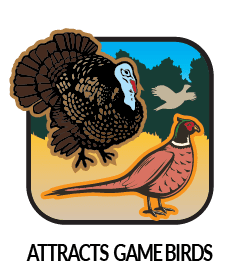American Plum
Plant Type: Dormant, bare-root
Zones: 3-8
Soil Type: Clay, Loamy & Sandy Soils
Site Selection: Full Sun, Partial Sun
Mature Height & Width: 15-25' Height and 10' Spread
Growth Rate: Fast - 24" or more per year once established
Moisture Requirements: Dry to wet soils






American Plum
Prunus americana
The American Plum is a fast growing selection with many wildlife benefits. This plum will grow as a small tree or large shrub which will readily sucker from the ground up around the root zone. When suckers are not trimmed regularly, it will transform into a large erect shrub and form a dense spreading thicket as it ages. In the spring, clusters of 1" white flowers will form, usually some of the first flower blooms in the woodlands. Fruit will form over summer, and mature in August and September. The plums can be used in jellies, preserves, and even eaten raw.
The American Plum is also known as the Wild Plum, Wild Yellow Plum or the Red Plum.
The leaves on the American Plum will grow as a fresh green color before turning red and pale yellow in autumn. The fruit of the American Plum will mature in August and September depending on your local climate. The 1" round plums are yellow and pale red as they develop, turning a deep red and purple color when mature. The American Plum will flower during the same time period that traditional Japanese Plums bloom. Since their pollen is compatible, they will pollinate each other and mutually increase each other's fruit production.
The American Plum forms a dense thicket with thorny branches when left to grow on its own. These thickets, along with highly desired fruit makes this a great choice for wildlife plantings. The roots of this shrub also hold soil in place, making it a wise choice for erosion control.
Fun Fact: The American Plum was widely used by Native Americans. The Cheyenne ate the plums and used its branches for the Sun Dance. The Navajo used the roots to make red dye.
Common uses for the American Plum include:
- Excellent choice for wildlife food and habitat
- Use in the lower story of a windbreak planting
- Dense roots hold soil, good for erosion control along stream banks
- Sour and sweet fruit used to make jellies, preserves or eaten raw
- Commonly found in forest openings, along railroad tracks, forest edges and in flood plains
The American Plum is a must if you are trying to attract and hold wildlife on your property. The thickets that are formed over time provide valuable protective shelter for a variety of nesting birds and mammals. Whitetail and Mule Deer are known to eat the fruit, twigs and leaves of this plum. Raccoons and squirrels eat the fruit and the flattened fruit seeds contained in the plums which are enjoyed by pheasants, grouse and an extensive list of songbirds. The American Plum will also a host a variety of butterflies.





